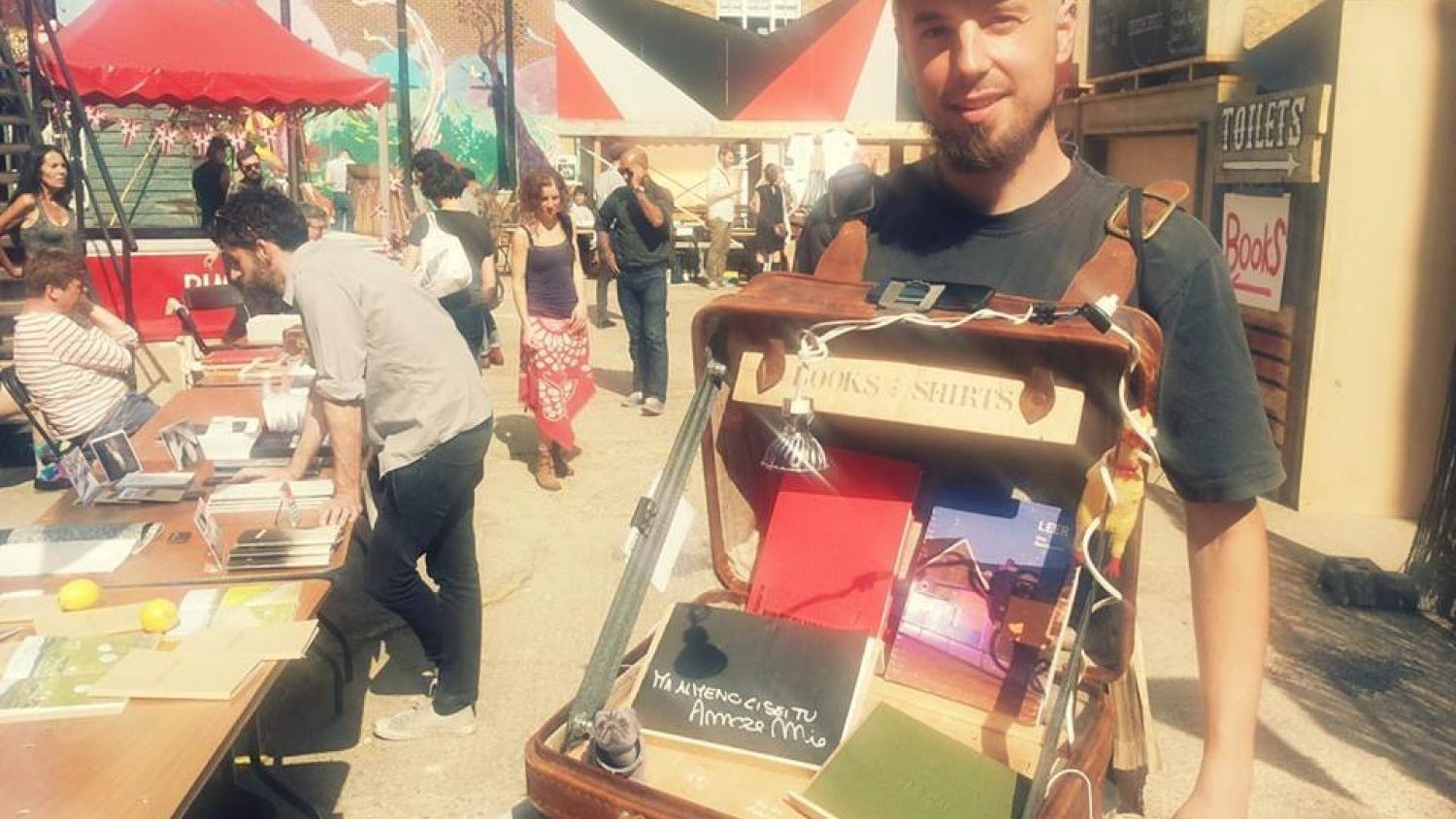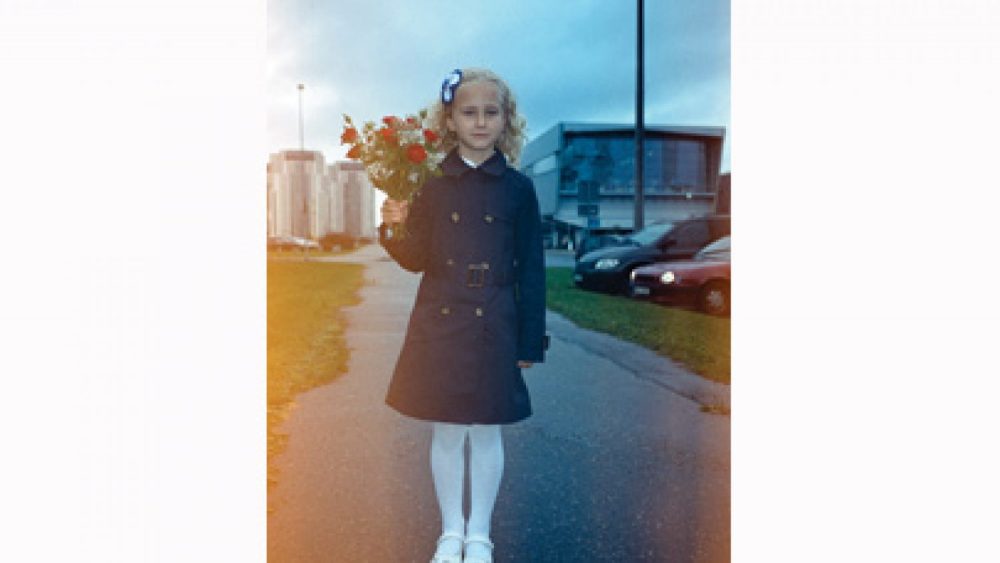Interview with Nico Baumgarten
The self-publishing movement has experienced a huge boom in the photography world during the last couple of years. This spring, during the Riga Photomonth, the Self Publish Riga event was held, dedicated to this phenomenon. Photographer and bookmaker Nico Baumgarten came to Riga to teach a workshop in bookmaking, as well as to participate as a jury member in the Self Publish Riga book contest. Nico has studied photography at the IDEP in Barcelona, and book binding in the CFP Bauer in Milan. He has self-published three books.
This wasn’t the first time Nico visited Latvia. He has participated in the ISSP, and has taught workshops in bookmaking to the students of the ISSP School. I believe that anyone that has had a chance to work together with him can testify to Nico’s amazing capacity for hard work, as well as his kindness, patience and competence when it comes to photobooks. Nico sees books as a way of liberation for the artist, a protest against the burdens of the art industry, and, basically, as a chance to “do what he or she wants”. A book is also a medium for stories much more complicated than those we can tell with a post on a website or even a gallery wall.
Nico is also one of the tutors at the ISSP 2014 this year, leading the workshop The Photobook: from Idea to Completion together with Rafal Milach and Ania Nalecka.
The phenomenon of self-publishing as a way of artistic expression has become very popular only quite recently. Why do you think it has evolved so quickly and tremendously?
I think this happened for two reasons. One is the technical advance – there aren’t any big obstacles to print a lot of pages at an affordable price. And the other reason – I believe that the photography world, and the art-world in general is an extremely elitist place, which forces you into very narrow roads. If you want to, for example, be exhibited in a gallery, you have to create photos where each picture is a perfect product for some investor – that’s what art collectors usually are – to buy. This really limits the ways of expressing yourself. It is also very difficult to get your work exhibited in a gallery, or a cultural institute, or a museum. But to self-publish a book – you don’t need the confirmation from anybody, you just do it yourself.
A third reason, which applies to the photobook in general, is that you have more and more complex possibilities of creating a message, of telling a story, or really doing anything you want with your photography. You can make a book with one photograph or with thousands of photographs, all of this has been done. You have a lot more options of how to deal with your work. Galleries, museums and also the editorial world limit you a lot in the way you present your work, while with photobooks you can be completely free.
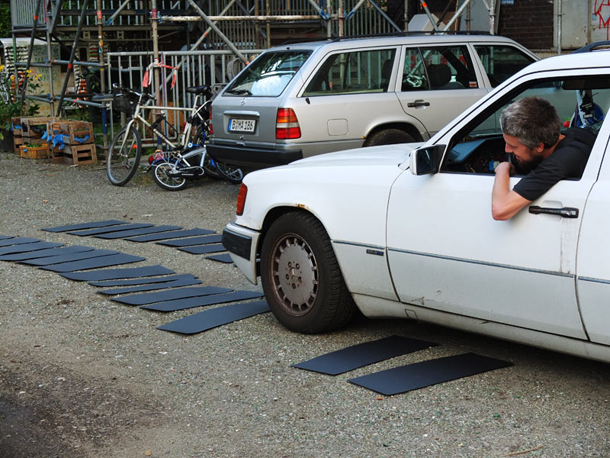
On the one hand, the process is much more democratic for the artist, but then there’s the book market where some of these books cost a fortune. Also, when you self–publish you usually release a small amount of books, so physically they can’t reach that many people. Is the movement really that democratic?
Exactly, from the author’s perspective it’s easier to express yourself through self-publishing photobooks. The fact that a lot of these works end up being something only for rich people is something that bothers me quite a bit. Once more the market is taking over artistic creation. As a committed self-publisher I think it is important to work on ruling out these mechanisms and not serving them. For example – offering a more beautiful version of your book for a wealthier audience or raising the price the closer your book gets to selling out; these are strategies that irritate me.
Still, compared to a gallery print, photobooks are way more affordable and easier to share, to show around. Let’s not even talk about the price per picture… So I would say that a first move has been done in stepping out of the white-cube realm but the same old establishment is trying to move it back in there. We have to be aware of this and oppose it.
Nowadays, a lot of people are speaking about the book as an object, instead of being just a means of transferring information.
With the whole self-publishing movement the artist’s book [a term used to refer to the book as an artistic object in itself, rather than just being a way to channel information. – IR] has become more widely known. More and more authors are getting more and more involved in the production process of the book, which makes it more authentic. There’s a bigger freedom to use different materials, to do funny stuff. If you asked a publishing house – “Hey, I want to use this material or want it with this gimmick”, the publishing house would say – “Okay, but that’s going to cost us X-times more.” Self-publishing photographers usually don’t self-publish to make money, they do it because they want to get their work out there.
I think that along with the self-publishing boom, there was another boom, where people got totally crazy about totally gimmicky books, where every book needed a special feature. But I believe that the book mainly needs to support its content. I see a lot of books that don’t make any sense – people think a lot about the book as an object, where they make this fancy thing, and that fancy thing, and obviously it gets more attention but it doesn’t help the story. For me, the classic bad example of this is David Allan Harvey’s book (based on a true story), which for me is just about a North American tourist who goes to Rio de Janeiro. He might be a well-known photographer but he takes photographs only of the clichés and stereotypes that really make life more difficult for a lot of Brazilians. Then he puts the story together as a fancy object, and therefore gets nominated for the Aperture Paris Photo book award. I mean for me as an author – you can do shitty books, it happens to all of us, but then I don’t understand why curators and people in the business get tricked by these cheap manoeuvres, by thinking “oh, this is a fancy object”.
However, I think this boom is a bit over, and with it the obsession with the craziness of the book format. MACK books is a good example – this year they have a lot of books with a much more classic design. For example, Janet Delaney’s book South of Market, which has a rather classic layout – it shows photos in the same size, sometimes they have a photo on the right, sometimes on the left or on both sides, but that’s it. And it totally makes sense – this book is really about the content, and shown in a rather traditional and very beautiful way.
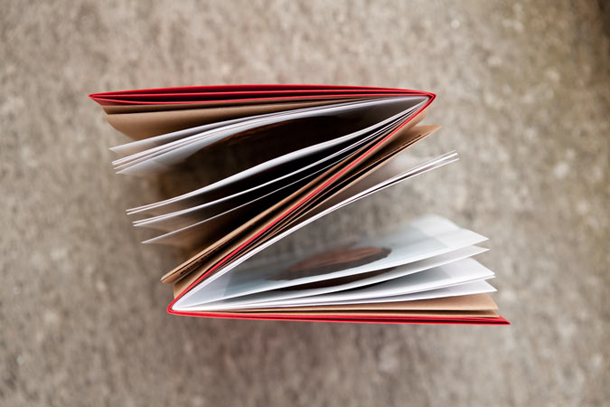
There are print-on-demand services such as Blurb, where all you do is upload the content and they create a book out of it. What do you think about that – do you consider it to be a self-published book as well?
Yes, it absolutely is self-publishing because you don’t have anybody who decides in your place whether the book gets out or not.
But in the mean time, and what we’ve been already talking about, is that self-publishing really allows you to explore the possibilities of a book as an object, whereas with Blurb, in a way, all of the books come out the same.
Yes, for me printing a book with Blurb isn’t interesting. I think that, as you’re saying – it’s very limiting. But it’s nice for people who mostly see their photos on a screen, and with Blurb they can experience them bound and printed on paper. At that point they have a book with their photos, and it’s already a step towards something else.
A thing to keep in mind is that Blurb now works together with Amazon. And Amazon is this one mega-company that is working hard on monopolising the book market. The have a business philosophy that is dramatically incompatible with the spirit of self-publishing.
Do you think every project is fit to become a book – that it’s just a matter of finding the right format – or do you think that some projects aren’t meant to transform in to books?
I think that not every project fits into a book format. What is beautiful about the book format is that there are a lot of directions you can take, you have a relatively high possibility that with whatever work you have you can still make a book out of it, but at the same time there is also a lot of work that doesn’t need a book. For example, all of these German objective typology kind of works – I can see the work in a book, and if it’s well printed, I can appreciate it. However, since the book in this case is just a container of the photographs, it’s not very interesting as a book itself, but it still gives me the possibility of sitting down on a sofa and looking at the photographs.
Nowadays, when we consume most of our daily information needs from digital devices and online media, how do you think the idea of a book as an object and an experience will impact the future of books in general?
If you look at the self-publishing boom, you can see that it happened more or less at the same time as the e-book boom. These are two directions in which the book currently develops.
I think it’s a good thing, because if you make something physical, if you cut down trees and fill up your room with physical objects, then it should have a reason. Nowadays, you have to justify the creation of a physical book, which is also why people make use of these gimmicky ideas and the book as an object, the book as an experience. If it’s only a sequence of pictures you might as well create a PDF and that’s fine as well.
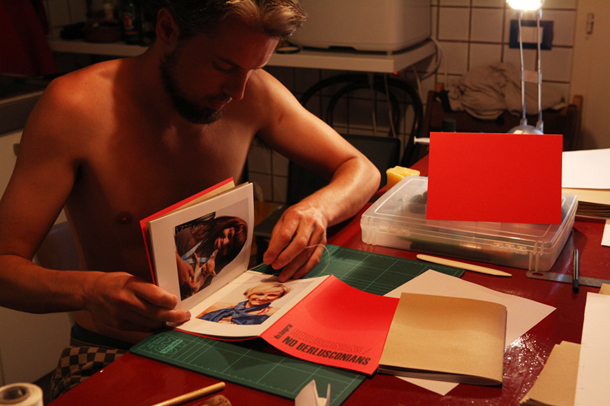
Could you tell me about the photographers whose work has made a special impression on you?
A book that really touches me is The Roma Journeys from Joakim Eskildsen. He’s a photographer who also studied the art of bookmaking. This project is about different Roma communities all over the world, he was travelling and working on the subject for seven years. So, he’s a bookmaker, and a great photographer, and what I understand from his photography is that he’s a great humanist too. This book goes way beyond all the clichés about the Roma people and hence is really an important contribution to raising the level of understanding and tolerance for these people. I’m interested in work which speaks about the world and which tries to make an impact on the world. The book has a lot of amazing texts, and great photographs – for me it has it all.
Another of them is definitely Juanan Requena, who I got to meet at the ISSP 2012. He has his travel diaries where you see so much stuff that in contemporary photo books is usually reproduced, but there you have it for real. You have ripped pages, you have totally damaged pages, hand scribbling on top of it, coffee stains, typewriter. He really squeezes his photographs or his entire book into the typewriter – don’t ask me how – and really types on to it. These are very touching and intimate works, and obviously one- of-a kind books. This for me is very beautiful and I find it very inspiring.
Personally, one of the things I like about photography is that you can easily share it with others. With a painting, you have to travel to the place where it’s located to experience it for real, so it’s much less accessible than a photograph, that can be experienced better on a screen than any painting ever really will be. But this kind of book you describe reverses it, because it’s also one–of–a–kind and can be fully experienced only in person.
Yes, but in this case when I experience Juanan’s book, I also get to meet Juanan, because he travels around with his books and shows them to people. The difference between this and a painting is that a painting usually takes up a couple of metres on each side – try fitting that into your hand-luggage. But Juanan can just put his book into his pocket and travel with it. And this way, it’s possible that even more people will see it than when a famous photographer releases an edition of 300 books, which will all end up in some collector’s bookshelf, where the books will be kept in mint condition, and nobody will ever really see them.
You’ve self-published three books – Berlusconians/No Berlusconians, Leer and ma almeno ci sei tu amore mio. Could you tell me more about the process of making books, and also about what comes after – the distribution and promotion, or in other words – how do you get them out there?
It was slightly different with each of the books, because I also get bored of repeating the same process. For Berlusconiants/No Berlusconians I looked at two very different groups of people who usually don’t mix too much. I wanted to express this through the book itself, that’s why I made this double binding (dos-à-dos). I put everybody inside the same book, but still with a maximum level of separation. So here the form really follows the content.
What came then was finding a place where I could print them. A place where I could also go behind the desk and push some buttons myself, stay there and talk to the printers, without paying for every minute I spent with them. For my first two books I also did crowdfunding, which was basically just a pre-sale of my book. I calculated that if I sell 40 – 50 copies of the book in advance, I could publish it, if not I wouldn’t be able afford the production. I didn’t use any crowdfunding platform, because I don’t believe that a lot of people stumble upon your project by accident – normally it’s the promotion you do with e-mails, word-of-mouth and social networks, amongst other things.
By the time I did my third book I was really tired of pre-sales and crowdfunding. It felt like I was annoying my friends a lot. I really don’t like to bother people by promoting the same stuff over and over again, I feel bad when I do that. So, now I said – I’m going to permit myself the luxury of just making it. I self-funded the book and then just threw it out there – which was a very big pleasure. On the other hand crowdfunding is a very good way to see whether there is a potential market for your book.
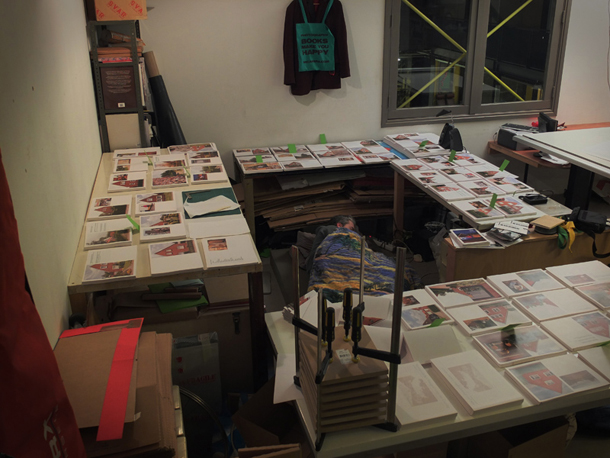
Why do you spend all that time working with your hands– what’s the pleasure in this kind of manual labour?
First of all, if I had the book being made by a bookbinder, it would be too expensive. I would have to make a much bigger edition for it to pay off, and I would probably get tired of the entire project very soon. Like this I just spend my own time, I don’t spend money. I have the luxury of working for myself, and doing what I love. I don’t earn a lot, but I manage not to spend a lot either. I really enjoy handcrafting my books – it’s a very precise, clean and calm way of working, and for me that’s really relaxing.
When I was doing Leer, which features a rather complicated binding, I was sometimes working until 5 o’clock in the morning. Then I would go to sleep, and when I woke up, even before my morning coffee, I would continue binding. I like that, it clears my mind. I spend so much time thinking about projects and concepts, this and that, but when I’m bookbinding I have a great inner peace. I’m discontent with photography in the sense that the physical aspect of it is only clicking a button, and then most of the work happens behind the computer. Integrating bookbinding and photography means more handwork, which I enjoy. I think it’s also very beautiful that the books come out of the same hands as the photographs taken.
There are a lot of photographers who make a book and the first thing they do is put it in an envelope and send it to Alec Soth or Martin Parr, hoping that they mention it somewhere. We’ve talked about this before and you’ve strongly denounced it – how do you work on the promotion and popularization of your books?
What I really like doing is showing my books to people, that’s why I do photography. So I enjoy having my books in my bag and showing them when there are interested people around. I also like to participate in independent publishing fairs and independent festivals – you meet nice people and you have nice afterparties. Another thing is letting people know about your books through blogs, so when I make a book I also make a video about it, I put it on Vimeo, and send them the link and sometimes they help you spreading the word. This way people can look at the whole book without having it in their hands, and they can judge up to a certain point – whether it interests them or not.
People like Martin Parr won’t get a free copy of my book because I don’t like the entire idea of having these mega-gurus who decide what’s good and what’s not. They do not represent the self-publishing scene, but they still dominate it. I think we have to build up a new generation of publishers and stop kissing the asses of yesterday’s authority figures. Self-publishing should be anti-establishment. The way things are going right now narrows down the very broad spectrum of the photography book scene. Look at all the photography blogs, which mention the same 30 – 40 book titles that everyone is mentioning that year. Luckily enough there are also some photography blogs that are really committed to showing you works you would otherwise not see.
When it comes to the promotion of your self-published books it is important to find your audience. And the audience changes depending on the topic of the book. I don’t see any sense in promoting work only inside the very small world of photobook-nerds. But I think it is a really good idea to promote a photobook – let’s say about architecture – also in places dedicated to architecture. In the end the photobook is just a format, it’s the content that matters and that should determine how you move and communicate.
Another thing I am trying out lately is to get out of the established ways of distributing books. There must be things beyond the Paypal-button on the homepage and the classical bookshop. I made myself a hawker’s tray that I first tried out at the Straybook festival in London. It was a really good experience and it really brought me closer to people. Luckily there are enough open-minded people like Vale and Ale from Akina Books and Markus Schaden who give space to different approaches.
Can you give me three reasons why a photographer should self-publish?
Firstly, to say “fuck you!” to the art-market. The other is to say “fuck you!” to the editorial market. And the third reason is – because it’s a way to express yourself through photography that is really adaptable to who you are, what you want to say and how you want to say it. It gives you very great creative freedom.
Photography blogs recommended by Nico:
Monsters and Madonnas: ICP library blog with in depth articles
the independent photobook: listing of self-published photobooks
Jörg Colberg’s photobook review videos on Youtube
The Photobook: In depth reviews / writings about photography books by Douglas Stockdale
American suburb X: collection of links to photobook reviews and related videos
The new frame: lots of short presentations by collector Eric Gunderson
